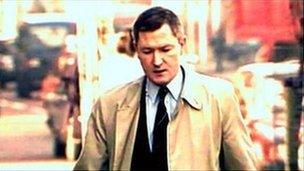Q&A: The murder of Pat Finucane
- Published

Patrick Finucane was shot dead in 1989
Pat Finucane's death was one of the most controversial killings during the Troubles - the decades of conflict in Northern Ireland that claimed the lives of more than 3,000 people.
Who was Pat Finucane?
Pat Finucane was a high-profile solicitor who lived and worked in Belfast. The 39-year-old Catholic was shot dead by loyalist paramilitaries in 1989.
In his role as a defence solicitor, he had represented both loyalists and republicans, including prominent members of the Irish Republican Army (IRA).
There have been long-standing allegations, which were later proven, that members of the UK security forces colluded in his murder.
How was he killed?
Pat Finucane was shot in front of his wife and three children at their family home in north Belfast on 12 February 1989.
The family were eating a Sunday meal at their kitchen table when loyalist paramilitaries used a sledgehammer to break into their house.
They opened fire, shooting the solicitor 14 times. He died at the scene.
Mr Finucane's now adult son, Michael, later wrote that the image of the attack had been "seared" into his mind. "The thing I remember most vividly is the noise; the reports of each bullet reverberating in the kitchen, how my grip on my younger brother and sister tightened with every shot," he recalled.
The Ulster Freedom Fighters (UFF), a cover name for the loyalist paramilitary group the Ulster Defence Association (UDA), later admitted carrying out the murder.
They claimed they had killed "Pat Finucane, the IRA officer".
The solicitor's family have always vehemently rejected any claim that Mr Finucane had been a member of the IRA and have been supported in this by the police.
Why is the case so controversial?
In the course of his work, Pat Finucane had represented a number of high-profile IRA prisoners, some of whom had taken part in hunger strikes at the Maze Prison.
The year before he died he had defended former IRA hunger striker Pat McGeown, who had been charged with helping to organise the murder of two Army corporals who drove into an IRA funeral cortege in west Belfast.
The mourners dragged the corporals from their car and took them to waste ground where they were shot dead by IRA gunmen.
The abduction was captured on TV and remains among the most disturbing images of the Troubles.
Mr Finucane succeeded in getting the charges against his client dropped, but a double agent passed a photograph of the solicitor, taken outside the court, to his killers.
The double agent was Brian Nelson, who compiled information on potential targets for the UDA, while at the same time working for British Army intelligence.
Has anyone been convicted of the murder?
In June 1999, a former UDA quartermaster and ex-RUC Special Branch agent, William Stobie, was charged with murdering Mr Finucane.
Stobie admitted supplying a weapon used in the killing, but denied murder.
Just over two years later, the case against him collapsed due to the refusal of a key witness to give evidence.
Stobie walked free from court but within weeks had been shot dead outside his own home by loyalist gunmen.
In May 2003, the loyalist Ken Barrett was arrested and charged with the murder of Mr Finucane.
Barrett, who drove the getaway car, later confessed and was sentenced to 22 years' imprisonment in September 2004. He was freed two years later under the terms of the Good Friday Agreement.
What was the de Silva review?
Former United Nations war crimes prosecutor Sir Desmond de Silva was asked by the government to carry out a review of all the existing documentation on the Finucane murder.
His report in 2012 confirmed that agents of the state were involved in the 1989 killing and that it should have been prevented.
It found RUC officers proposed Mr Finucane be killed, said they passed information to his killers, failed to stop the attack and then obstructed the murder investigation.
It also found that an Army intelligence unit, the FRU, "bears a degree" of responsibility because one of their agents, Brian Nelson, was involved in selecting targets.
Sir Desmond found that there was "no over-arching state conspiracy", but his report prompted then Prime Minister David Cameron to apologise for "frankly shocking levels of collusion".
The Finucanes argued that the report left many questions unanswered.
What does the family want?
The Finucane family have campaigned for a full public inquiry into the murder for many years and have repeatedly insisted that they will not accept anything less.
Mr Finucane's son John became a Sinn Féin councillor and Lord Mayor of Belfast and was elected MP for North Belfast in December 2019.
The family believe that a public inquiry, where the veracity of documents and witnesses can be tested under cross-examination, is the best way of getting to the truth about the extent of security force collusion and exactly who knew what.
Public inquiries are set up to uncover the truth following scandals or perceived injustices. The test that must be satisfied in order to hold an inquiry is that it is of "public concern".
While often chaired by a judge, a public inquiry is not a court of law and cannot determine liability.
In September 2019, the Finucane family launched legal action in an attempt to force the government to hold a public inquiry.
In October 2020, a lawyer for the NI Secretary told a court that a decision would be made before the end of November.
This article was updated on 28 November 2020.
- Published12 December 2012
